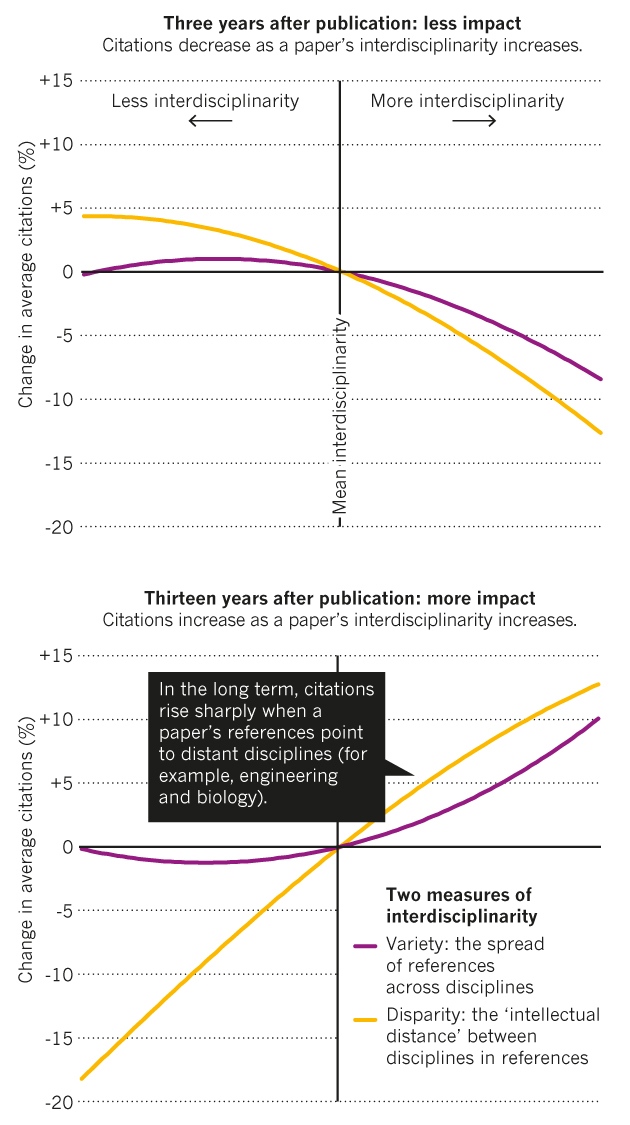Interdisciplinary studies rooted in needs of society

According to a study published in PLoS ONE, a peer-reviewed open access scientific journal published by the Public Library of Science (PLOS), interdisciplinary research takes time to have an impact. Over three years, papers with diverse references tend to pick up fewer citations than the norm, but over 13 years they gain more.
Interdisciplinary research originated as a response to the demands of society. Since the 1950s, the task of knowing and reforming the world has become increasingly complex and multifaceted. No single discipline of the natural sciences is capable of researching and applying many of the technologies directly related to people’s standard of living, such as new energy, new materials, precision manufacturing and aerospace technology.
Based on this understanding, many industrialized countries have formulated policies to fund interdisciplinary research to guide long-term planning for science and technology development.
In addition, the theoretical and practical problems that countries face include both regional ones, such as China’s population growth, aging population and urbanization, as well as global problems, such as the exploitation of resources, ecological protection and governance, and income inequality. To solve these problems, natural science and technology are indispensable, but radical and fundamental solutions cannot be achieved exclusively within the domain of the natural sciences.
The core of social problems is social activities and interactions between people. The activities of human beings have to follow the principles of nature and social values. Practical processes must follow the laws of nature, which fall under the purview of the natural sciences. Social values require the result of measures to comply with the fundamental interests of human beings, which involves philosophy and the social science. For a long time, natural science, technology, philosophy and social science, developed independently along separate paths with little communication and interaction. What was worse was that the two major fields of knowledge are split and even antagonistic at times.
In 1959, the British scholar C.P. Snow pointed out that natural science and humanities had been in opposition for a long time. Snow argued that the confrontation of the two cultures has impeded the solution of a series of major social problems, which involve natural science, philosophy and social science. Snow’s proposition opened up a new field of research that views science, technology and society as a whole as the object of study.
Man, nature, society
Based on the internal link connecting man, nature and society, the development of natural science, philosophy and the social sciences will definitely transcend boundaries, leading to the emergence of interdisciplinary research between fields that are seemingly unrelated. For example, traditional ecology, which studies the relationship between living things and their environment, is based on biology. Once environmental problems caused by humans began to be a threat to their own survival in the mid-20th century, ecology was expanded to include humans and their social activities. The discipline was then transformed into social ecology, which focuses on the ecosystem of human society.
Social ecology, as a cross-disciplinary subject, has made modern ecology the link between natural science and liberal arts. In fact, other disciplines link the two together. As humans gain a better understanding of nature and the world, natural and social science will be increasingly integrated with each other.
Predicting future trends
Since 1970, the Japanese science and technology agency has issued predictions about the future of technology every five years to anticipate the country’s social needs. Many countries have emulated Japan’s approach. According to the national conditions and social realities, scientific authorities gather to plot the course of science and technology on a regular basis.
In 2002, the Chinese Academy of Sciences launched a research program to forecast the development of Chinese technology over the next 20 years. Technology predictions are based on a systematic study of how science and technology and the social economy will develop in the years to come in order to identify emerging generic technologies that may generate substantial economic and social effects.
Achieving an accurate prediction requires not only scientists and engineers from different fields of science and technology but also representatives from the fields of industry, education, public policy and other social sectors. The questionnaires on the future of technology also cover all social sectors to take into account the long-term social needs of different groups. The result of technology forecasts is thus an important basis on which the government makes its long-term science and technological policies, which mainly involves selecting a series of crucial technologies and relevant key research areas.
The aftereffect of technological forecasts is a vision for social development and coordinated actions from all social sectors that come after the consensus is reached. Through effective communication, the innovators of generic technology in the future will come to understand the demands of others operating in different fields, which is helpful for conducting related research activities with the same technological targets. This means that research activities conducted for the realization of a shared vision will definitely involve different disciplines. In this sense, farsighted policymaking will objectively foster interdisciplinary research.
